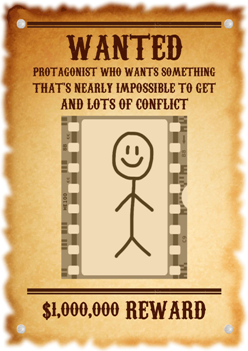 The hero in every story must face many obstacles before reaching his ultimate goal. Maybe a prince wants to save a princess from a fire-breathing dragon. Saving the princess is the external conflict. Once the external conflict is resolved, the story is over.
The hero in every story must face many obstacles before reaching his ultimate goal. Maybe a prince wants to save a princess from a fire-breathing dragon. Saving the princess is the external conflict. Once the external conflict is resolved, the story is over.
In the best stories, the obstacle within the hero (internal conflict) is the one he finds most difficult to face. The internal conflict has to do with the character’s belief system, which keeps him from reaching his external goal. Typically, the protagonist is tormented by a wound from his past, and this wound is something that happens before the story begins. The protagonist usually doesn’t realize this wound is influencing his behavior. Maybe a prince watched his family burn in a fire when he was a child, but he needs to overcome his fear of fire to defeat the fire-breathing dragon and save the princess.
Using a Prologue to Introduce the Wound
Writers may wonder the best way to introduce a character’s wound. One way (not the best) to introduce a character’s wound is with a prologue. In the movie Twister, Helen Hunt plays the role of Dr. Jo Harding, who is a storm chaser. The movie begins with Harding watching her father being swept away by a tornado when she was a child. However, most movies don’t use a prologue to show a character’s wound. The wound is part of the character’s backstory. I often advise writers not to use a prologue to introduce a character’s wound. While a prologue is a convenient way for the writer to inform readers about a character’s past, most of the time, a prologue is not the best way to elicit an emotional response from a reader or viewer.
If I happen to watch or read a news report about a bus hitting someone I don’t know, it doesn’t matter in the same way that it would if that news report was about a bus hitting a neighbor or a friend. That’s why many writers opt to introduce a character and get the reader to care about that character before showing his wound. I recently critiqued a manuscript that began with a prologue wherein a child was struggling to save himself after a canoe overturned and his parents drowned. Of course, the child turned out to be the hero in the story. While I was reading the prologue, I kept thinking how much more effective the story could be if the writer would wait and add the backstory later. Sure, it’s always sad when a child is involved in a boating accident. However, it’s always easier to feel the pain of someone you know. It’s hard for writers to keep important information about their main characters to themselves, but nevertheless, wise writers play a waiting game before they skillfully let the story thunder rumble. They weave in the pieces of backstory in small bits. Imagine if the movie Silence of the Lambs had begun with a prologue showing what had happened to Clarice Starling as a child. It wouldn’t have been nearly as effective or exciting as Hannibal Lecter coaxing the information out of her.
Using a Flashback to Introduce the Wound
Flashbacks are another method writers sometimes choose to introduce a character’s wound. Story guru Michael Hauge admits in an interview with Film Courage that he’s “not really fond of flashbacks as a rule, especially to reveal wounds.” One movie that Hauge feels is an exception is Hitch. He explains:
But in that movie, it works I think because it’s such a funny flashback as well as touching, and it establishes such an important quality for the character of Hitch. Because we see when he was in college, he had his heart broken and that’s when he acquired the belief that if I fall in love with anybody, it’s going to lead to a broken heart. Which leads to his identity, his I’ll help everyone else fall in love but I don’t do that; that’s not for me.
Screenwriters and novelists pay Michael Hauge lots of money (hundreds of dollars an hour) for his advice, and I have no doubt that it’s worth every penny. The man knows how to tell a story. I would advise any writer to seek out his books, interviews, workshops, and blog posts. Hauge is clear in his assertion that in most cases, the writer does not want to announce a character’s wound at the beginning. There are always exceptions, but it’s more common not to reveal the wound until well into the story. Hauge notes that the movie Good Will Hunting is half over before the viewer learns about the abuse Will suffered as a child.
Using Dialogue to Introduce the Wound
So, how does a good writer reveal a character’s wound? Michael Hauge offers writers this advice in the interview with Film Courage:
One of the most effective ways to reveal the wound is through dialogue. It’s oftentimes more powerful to hear about a wound that a character suffered than to watch it on a screen.
In the movie Fifty Shades of Grey, the viewer learns that Christian Grey was horribly abused as a child when he confesses his past to Anastasia during an intimate moment, well into the movie. It would’ve been a nauseating experience for movie viewers to have to watch a child being abused onscreen. It’s a much more moving experience for the viewer to piece things together as information is slowly revealed through dialogue. Writers are often told to show rather than tell, and this is good advice much of the time. However, readers and viewers of most types of fiction take no joy out of reading about or watching children suffer. However, it’s always satisfying when, in an emotional moment, a character confides in another character about his past.
Let the Reader Make Inferences About the Wound
In some stories, the wound is never clearly stated. After all, it’s most important for the writer to know what the character’s wound is. The writer has to know the backstory for the hero well enough to understand what wounded him in the past that made him the way he is in the present. Although it may be tempting to use prologues and flashbacks to introduce character wounds, it’s almost always better to wait and introduce the wound through dialogue.
What do you think? Feel free to let me know in the comments below. Comments are moderated in order to maintain the spam-free, family atmosphere.
Until next time,
Write something you love! — Joanne
WriteSomethingYouLove.com




 The hero in every story must face many obstacles before reaching his ultimate goal. Maybe a prince wants to save a princess from a fire-breathing dragon. Saving the princess is the external conflict. Once the external conflict is resolved, the story is over.
The hero in every story must face many obstacles before reaching his ultimate goal. Maybe a prince wants to save a princess from a fire-breathing dragon. Saving the princess is the external conflict. Once the external conflict is resolved, the story is over. QUESTION: What’s the problem with opening a novel with dialogue?
QUESTION: What’s the problem with opening a novel with dialogue? Many writers wonder when the word that should be used and when it should be omitted. Because the word that can function in so many ways, the answer isn’t simple. When in doubt, opt for clarity. Here are some of the ways the word that may be used:
Many writers wonder when the word that should be used and when it should be omitted. Because the word that can function in so many ways, the answer isn’t simple. When in doubt, opt for clarity. Here are some of the ways the word that may be used:

